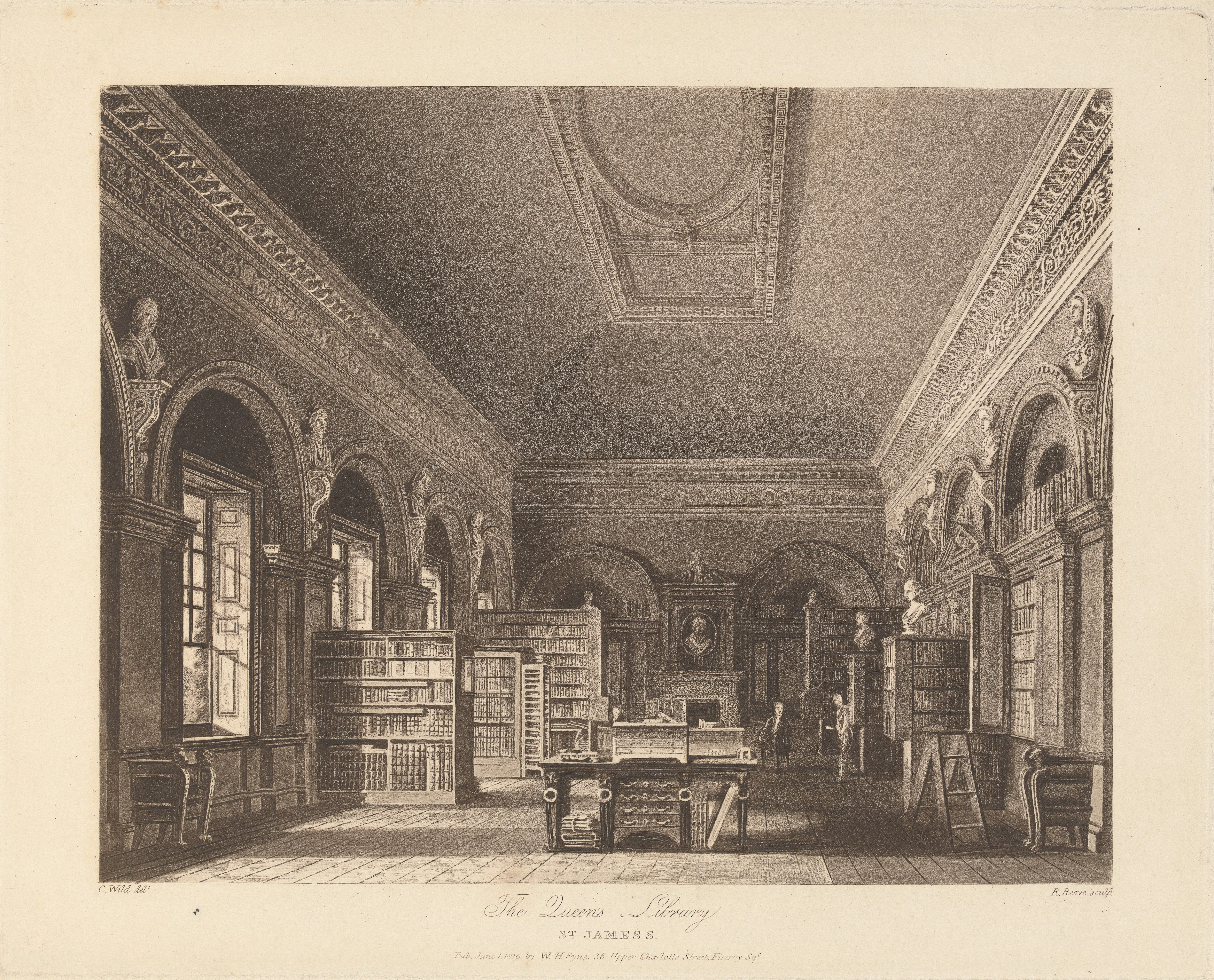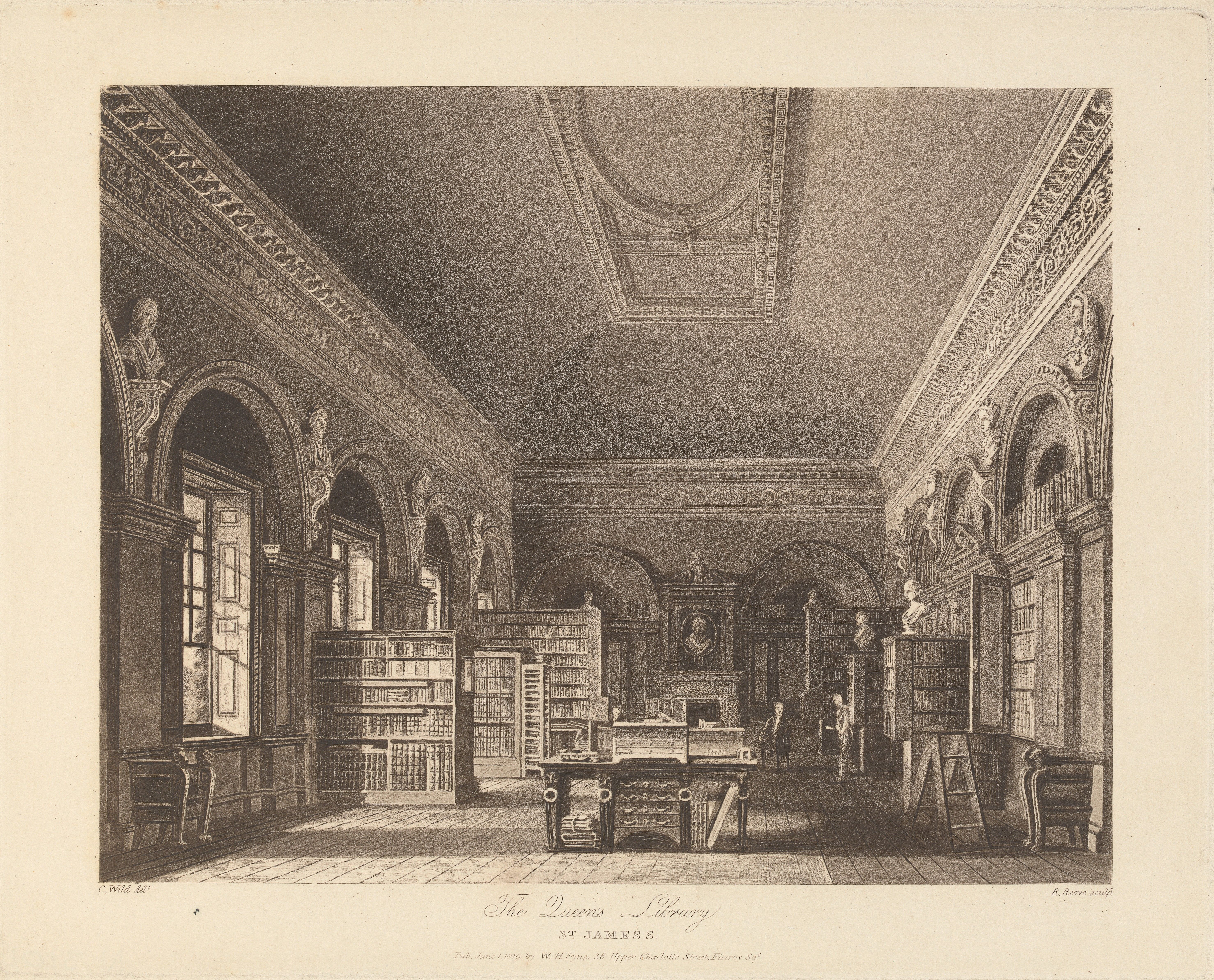This post is part of our By Our Books: Bibliography in the WPHP Spotlight Series, which will run through July 2023. This series attends to the bibliographical fields of the WPHP title records, tracing the history of our thinking about our descriptive practices and how they are informed by the sources available to us and by our feminist ambition to recognize and reconstruct women’s labour in print, broadly conceived.
Authored by: Michelle Levy
Edited by: Kandice Sharren and Kate Moffatt
Submitted on: 07/01/2023
Citation: Levy, Michelle. “By Our Books: Bibliography in the WPHP Mini-Spotlight Series.” The Women’s Print History Project, 1 July 2023, https://womensprinthistoryproject.com/blog/post/120.
 Figure 1. Richard Gilson Reeve, 1803–1889, The Queen's Library, 1819, Aquatint, Yale Center for British Art, Paul Mellon Collection, B1977.14.18164.
Figure 1. Richard Gilson Reeve, 1803–1889, The Queen's Library, 1819, Aquatint, Yale Center for British Art, Paul Mellon Collection, B1977.14.18164.
“In deciding what and how much [information about the book as a material object] to include, the bibliographer must ask himself repeatedly: ‘What is the purpose of the descriptions? Who really needs each item of information? Can anything be abbreviated? Only thus can he avoid burdensome and expensive superfluity, and escape the ultimate absurdity of mistaking the means of bibliography for its end, of practising bibliography for bibliography’s sake.” (Gaskell 322)
In designing our data model for the WPHP—a process that began in 2014 and is still evolving—we have kept Gaskell’s questions very much at the forefront. What is the purpose of our descriptions? Who do they serve? What information is essential and what can be dispensed with? Gaskell’s questions are ostensibly gender-neutral. But he assumes a male bibliographer, and as creators of a database intended to capture women’s engagement with print over the long eighteenth century, we had to ask ourselves whether extant bibliographical procedures allow us to ask and answer the questions that we are interested in about women’s books.
Our response to this issue has always been, yes and no. On the one hand, bibliographical methods and definitions have been developed over decades of intense consideration of books as material objects, and it makes sense to attend to them closely. On the other hand, these methods are not always attuned to the kinds of identifications and descriptions we need to understand how women participated in print culture. Hence the title of this series: instead of doing bibliography "by the book," as it were, we do it "by our books."
In this mini-spotlight series, we offer a set of reflections about the many conversations, debates and second guessing we have done about our data fields, some of which, such as imprint, colophon, and format are foundational to bibliography, and others, such as “signed author,” that we have implemented in order to capture information about how women’s books signal themselves to the world. Even some seemingly uncontroversial designations, like what constitutes a title, or location, are actually more complicated than they first appear. In these short essays (hence the “mini-”), we trace the history of our thinking about our descriptive practices, how they are informed by the sources available to us and by our feminist ambition to recognize and reconstruct women’s labour in print, broadly conceived. The spotlights will be released twice weekly until early August; we hope you join us for this journey through many of the key data fields in our WPHP records.
On July 5, Sara Penn takes us through the "Title" field in her Spotlight "What's in a Title?"
On July 6, Amanda Law's Spotlight, "(Contributor) Role Call," will describe our "Contributors" field.
On July 10, Belle Eist, in “Printed by—”: Imprints and Firms in the WPHP," will explore the "Firms" and "Imprint" fields.
On July 12, Kate Ozment's Spotlight, "The Language of Authorship," will attend to the "Signed Author" field.
On July 17, Isabelle Burrows will explain our "Genre" field in her Spotlight, "Making Genre-alizations: Genre Designations in the WPHP."
On July 19, Tammy T.'s Spotlight, "Voluminous Decisions," will describe our "Volumes" field.
On July 26, Michelle Levy's Spotlight, "Matters of Format," explains our "Format" field.
On July 28, Julianna Wagar explores the "Pseudonym" field in "What's in a Name?: Pseudonymous Texts in the WPHP."
On August 2, Kate Moffatt takes up the hidden treasure that is the "Colophon" field in her Spotlight, "Colophons Count."
On August 4, the Spotlight Series wraps up with Kandice Sharren's Spotlight, "The Edition Issue," on our edition fields: "Edition Number" and "Edition Statement."
